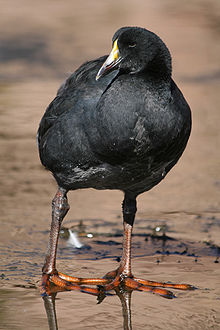Giant coot
| Giant coot | |
|---|---|

| |
| in northern Chile | |
| Scientific classification | |
| Domain: | Eukaryota |
| Kingdom: | Animalia |
| Phylum: | Chordata |
| Class: | Aves |
| Order: | Gruiformes |
| Family: | Rallidae |
| Genus: | Fulica |
| Species: | F. gigantea
|
| Binomial name | |
| Fulica gigantea | |
The giant coot (Fulica gigantea) is a species of coot from South America. It is found at lakes in the altiplano from central Peru, through western Bolivia, to north-eastern Chile and extreme north-western Argentina.
Description
With a total length of 48–64 cm (19–25 in),[2] it is the second largest extant member of the family Rallidae, after the takahe, and adults are considered functionally flightless.[3] It is the only coot with reddish legs.[2] It has a small white frontal shield. Its beak is tipped black. An adult male weighed 2.7 kg (6.0 lb) while three adult females weighed 2.03–2.4 kg (4.5–5.3 lb).[4]
Breeding
As in the related horned coot, the giant coot is monogamous and the pair builds a huge nest in a highland lake. However, unlike the horned coot, the nest of the giant coot is primarily made of aquatic vegetation and – as it is fiercely territorial – it never forms colonies.[3]
Gallery
-
Young
-
Adult and young feeding
-
Giant coot with several young
-
Several adult Giant Coots resting on land at Chungara Park, northernmost Chile.
References
- ^ BirdLife International (2012). "Fulica gigantea". IUCN Red List of Threatened Species. 2012. Retrieved 26 November 2013.
{{cite journal}}: Invalid|ref=harv(help) - ^ a b Jaramillo, A. Burke, P., & Beadle, D. (2003). Birds of Chile. Christopher Helm. ISBN 0-7136-4688-8
- ^ a b Taylor, P. B. (1996). Giant Coot (Fulica gigantea). pp. 209 in: del Hoyo, J., Elliott, A. & Sargatal, J. eds. (1996). Handbook of the Birds of the World. Vol. 3. Hoatzins to Auks. Lynx Edicions, Barcelona. ISBN 84-87334-20-2
- ^ Taylor, Barry, Rails: A Guide to the Rails, Crakes, Gallinules and Coots of the World. Yale University Press (1998), ISBN 978-0-300-07758-2.





